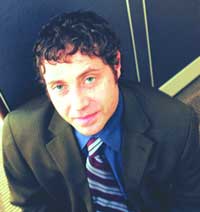Data Centers: The heat is on


Connecting state and local government leaders
EPA's Energy Star program could focus on power consumption in the server room.

If you are just buying a server based on what the stated cost is, and don't take into account operations, you are missing half to two-thirds of your expenses.' Andrew Fanara, Energy Star
Rick Steele
In a data center, less than 50 percent of the electricity goes to the servers' CPUs, and some of that is converted to heat. The rest of the electricity is used to run other components of the servers, the center's cooling system, or is lost in power supplies, uninterruptible power supplies and switches. While this is a problem for a data center manager trying to stay on budget, it is also becoming a national concern.
The Environmental Protection Agency and the Energy Department are focusing on data centers as an important and emerging sector in the economy from a standpoint of energy consumption, said Andrew Fanara, product development team leader for EPA's Energy Star program.
'All federal departments rely on the management of data to fulfill their missions, but also, those data centers are critical in facilitating our competitive economy,' Fanara said.
Data centers, however, come at a high cost in terms of energy independence and environmental damage. According to Jonathan Koomey, Osman Sezgen and Robert Steimetz of the Lawrence Berkeley National Laboratory at the University of California, data centers in California alone consumed between 2,000 and 3,000 gigawatt hours of electricity in 2001, and that figure has risen considerably since then. (One gigawatt, according to California's Consumer Energy Center, provides power enough for 1 million average homes.)
Congress took note this year, and last December passed HR 5646, which would require the Energy Star program to analyze 'the rapid growth and energy consumption of computer data centers by the federal government and private enterprise.'
But EPA didn't wait for congressional action. It was already working on ways to cut such power usage.
'We are officially starting our research to determine if an Energy Star category for servers will be effective in the marketplace,' Fanara said.
Awarding Stars
EPA launched the Energy Star program in 1992 as a means of saving energy and cutting greenhouse emissions. It has a staff of about 100 and covers three areas: homes, commercial buildings and electrical/electronic products. The program involves certifying products as being energy-efficient as a means of encouraging their purchase.
'These are voluntary standards, but not for government buyers,' Fanara said. 'There was an Executive Order signed by President Clinton and updated by President Bush that says where there is an Energy Star category, federal buyers are required to purchase Energy Star products.'
The program initially targeted computers and monitors. But over the years it has grown to cover more than 50 categories of certified products. According to EPA, consumers in the U.S. have now purchased more than 2 billion Energy Star products.
In 2005, the use of Energy Star products helped Americans
significantly reduce electricity consumption and save $12 billion on utility bills, while preventing greenhouse gas emissions equivalent to those from 23 million vehicles, EPA said.
Standards for more categories of products are imminent. The latest standard, covering imaging machines such as copiers, fax machines, printers and scanners, will take effect April 1. And on July 20, new standards for desktop and notebook PCs, and PC-based servers will be implemented.
'For the first time, these specs recognize the most efficient products when they are actually in use,' Fanara said. 'That is a huge sea change. We are very pleased and very much looking forward to getting a lot of new products out there.'
While PCs and monitors are relatively easy to compare, it gets far more complex when evaluating servers'an IBM zSeries mainframe from IBM Corp. versus a cluster of virtualized single-processor boxes from Dell Inc., for example.
Nevertheless, EPA is exploring the addition of an Energy Star category for servers.
Last December, agency officials met with top industry representatives to consider potential server standards.
One difficulty, however, is determining exactly how to measure a server's electrical efficiency.
'Power consumption is increasingly important to IT managers because they want to use their budgets most effectively, and electricity is a large portion of the overall budget,' said Walter Bays, president of the Standard Performance Evaluation Corporation (SPEC), a nonprofit organization that creates benchmarks for high-performance computers. 'Currently, many vendors report some energy efficiency figures, but these are often not directly comparable due to differences in workload, configuration, test environment, etc.'
To address these issues, EPA convened two meetings of industry representatives last year to hammer out a protocol for measuring server energy usage in relation to performance. The protocol was finalized last November.
'The purpose of the protocol is to provide a way to attach energy measurements when you are doing the performance testing,' said Jonathan Koomey, a staff scientist at Lawrence Berkeley National Laboratory and consulting professor at Stanford University, who co-authored the protocol.
A Parallel Course
SPEC, meanwhile, is pursuing a parallel set of metrics.
'SPEC wants to define server energy measurement standards in the same way we have done for performance,' Bays said. 'This should help IT managers in their acquisitions to consider power efficiency along with their other selection criteria. It may also help them use their data center equipment, existing as well as new, more efficiently.'
He said that the group agreed to focus on small to midsize servers. As a result, the metric might not be applicable to notebook PCs or very large servers.
Challenges include defining the scope of the benchmark, selecting the workloads, defining test conditions and specifying the measurement protocol. The metric also will have to be extensible enough to address other servers not covered in the initial benchmark.
'We have reached agreement on the major issues, are testing benchmark prototypes and are making good progress towards a benchmark release,' Bays said. He is shooting for a release before the middle of the year, but it is too early to commit to a date. 'Even if the subcommittee has a date scheduled, if unexpected information shows a benchmark anomaly, then we would hold the release to fix it,' he added.
But the servers themselves are only one small part of achieving the overall goal of reducing energy consumption and emissions.
'The Energy Star commercial buildings team is working on developing a whole data center benchmark, which is way of grading the efficiency of the whole ecosystem,' Fanara said.
According to Kenneth Brill, president of the Uptime Institute in Santa Fe, N.M., only 40 percent of the power that enters a data center even reaches the computing equipment. The rest is consumed by the infrastructure'environmental control, UPS units and the like.
The rule of thumb is that for every kilowatt you save in the servers, you save another kilowatt on cooling. Cutting down on power consumption in the servers not only saves on power bills but also saves on capital costs'$12,000 minimum for upstream support equipment for cooling and backup power for every kilowatt used by the servers.
'And that is the minimum; it can be double that amount,' Brill said. 'Plus there is $3,500 per kilowatt per year to pay for all the site costs.'
He said that by applying best practices, data centers can cut their energy usage by 10 percent to 50 percent, without heavy capital expenditures.
There are many actions being taken to reduce power consumption at every level. Intel Corp. and Advanced Micro Devices Inc. are switching to multi-core, lower clock-speed processors, which consume less power and produce less heat in servers, switches and PCs.
The 80 Plus program (www.80plus. org) has spent the past five years working on more efficient power supplies.
'Five years ago, the average power supplies were operating between 60 and 70 percent efficiency, and the power factor correction was horrible in these devices,' said Kent Dunn, director of energy and original equipment manufacturers partnerships for Verdiem Corp. of Seattle and program manager for 80 Plus.
By the Numbers
'An 80 Plus power supply on its own saves 85 kilowatt hours compared to its predecessors, then add 25 kilowatt hours for power factor correction, plus the benefit you get from reducing the load on the cooling system, and you start looking at 130 to 140 kilowatt hours per year.'
Then there are UPS units. Lawrence Berkeley researcher William Tschudi recently built a test data center that operated on direct current rather than running alternating current to the servers and then converting it to DC. He found that this resulted in a 10 to 20 percent reduction in the electrical load, depending on what type of UPS system was used.
'In almost any part of the infrastructure chain or inside the servers, there are opportunities to save energy,' Tschudi said. 'There is no one silver bullet that solves the energy problem. There are a lot of little silver BBs.'
NEXT STORY: Waxman to probe Doan's dealings




